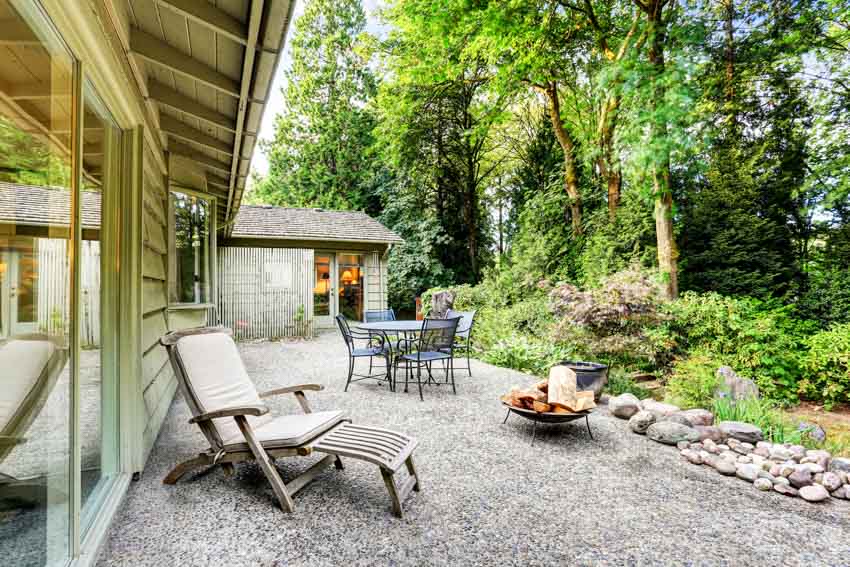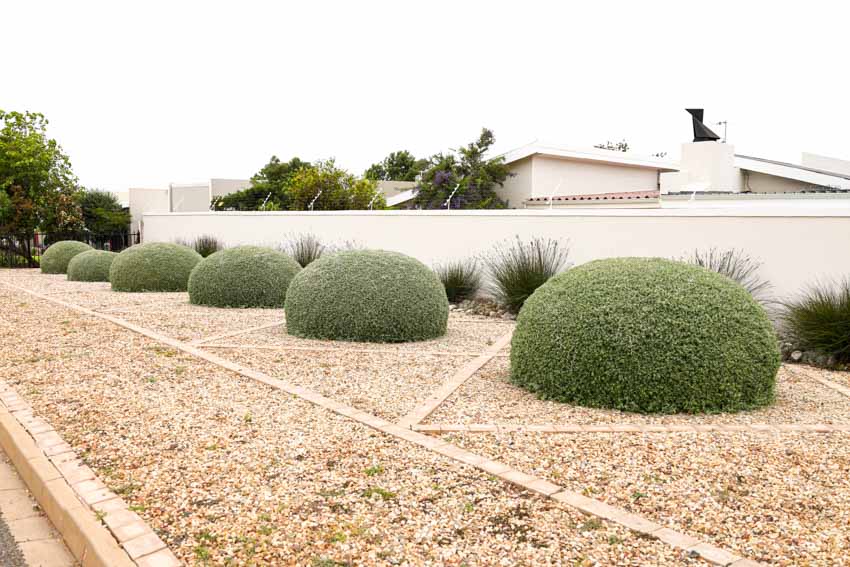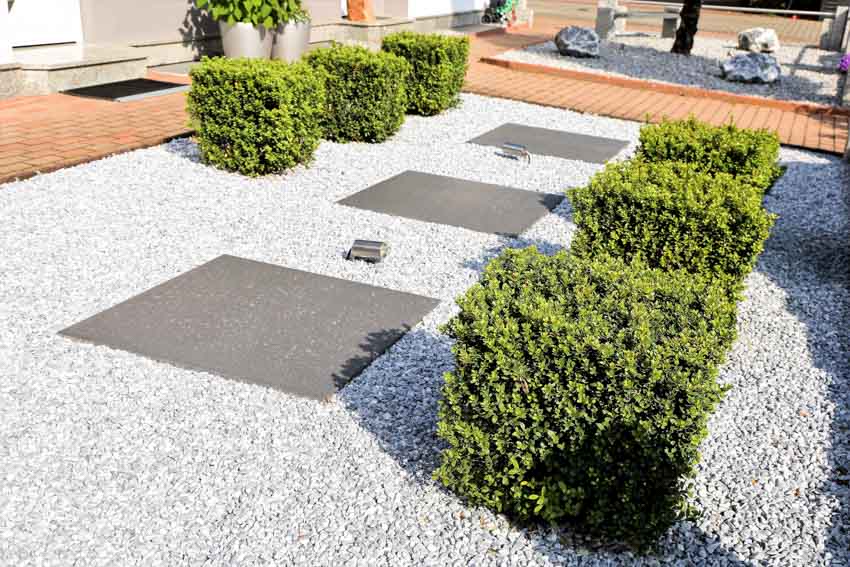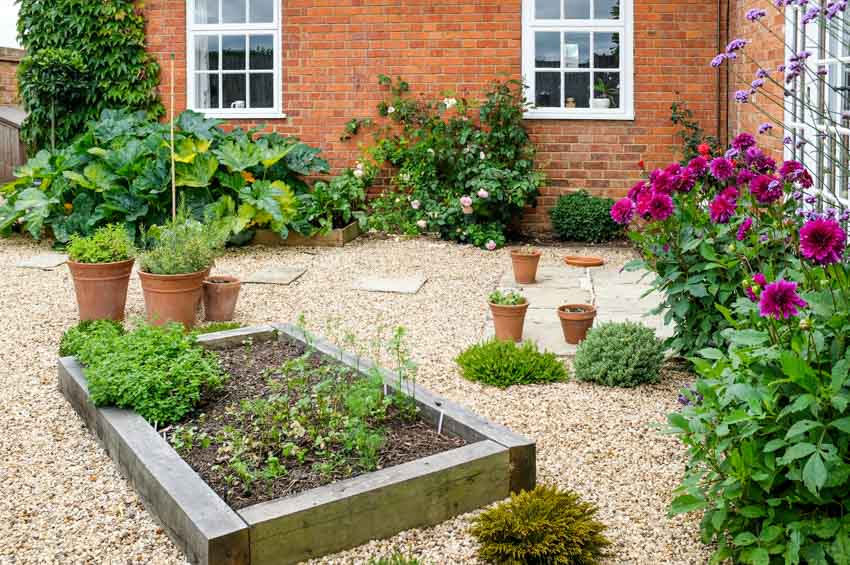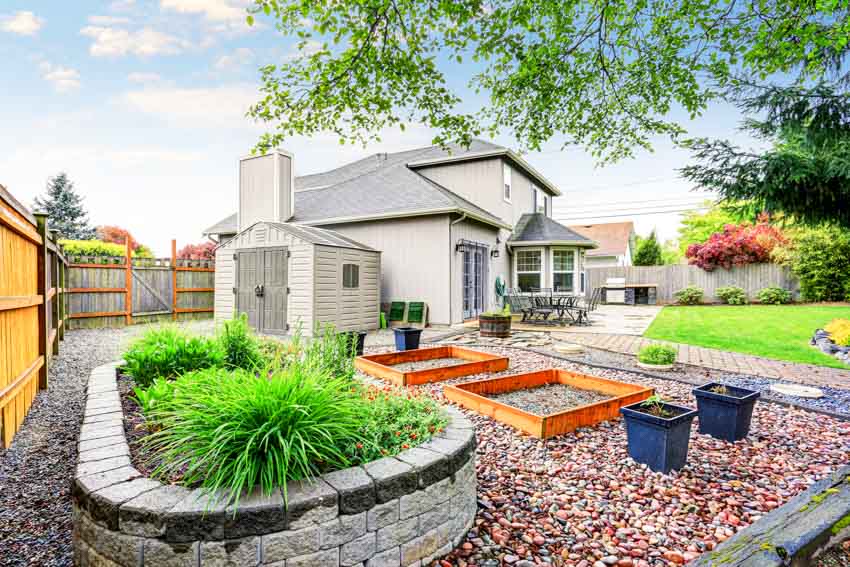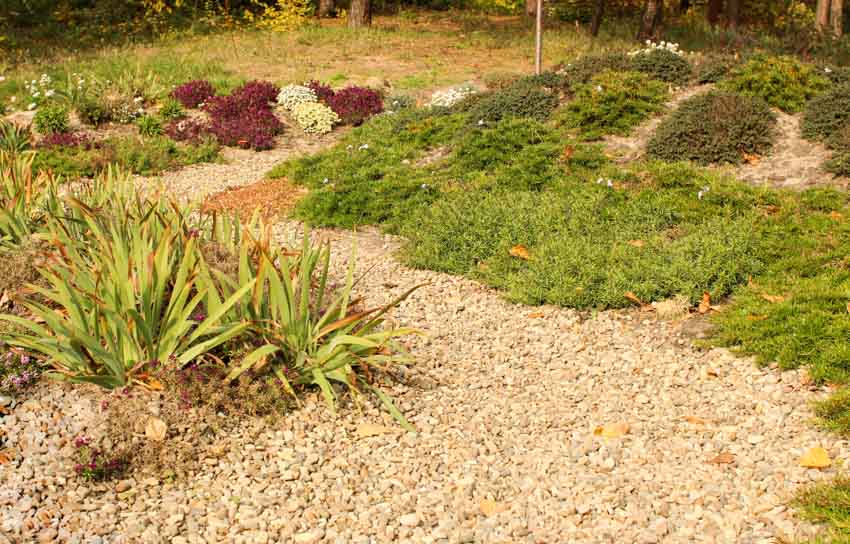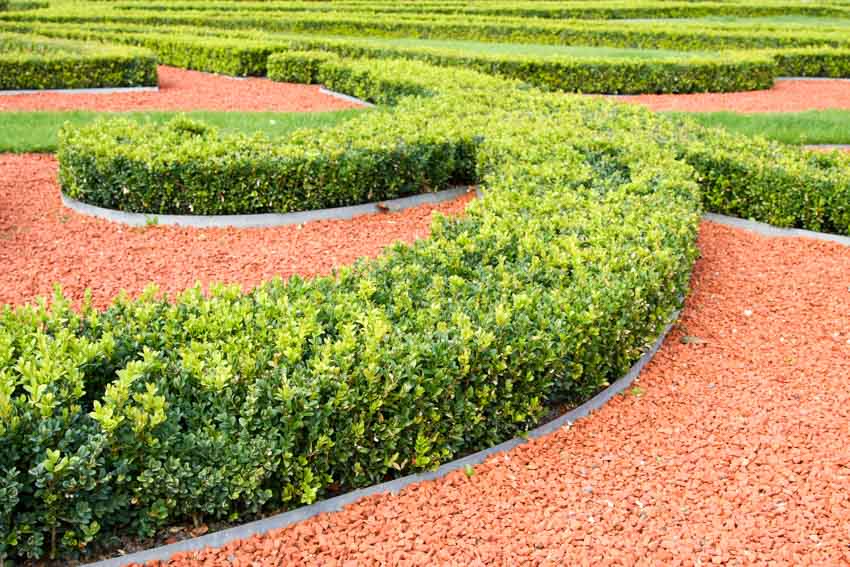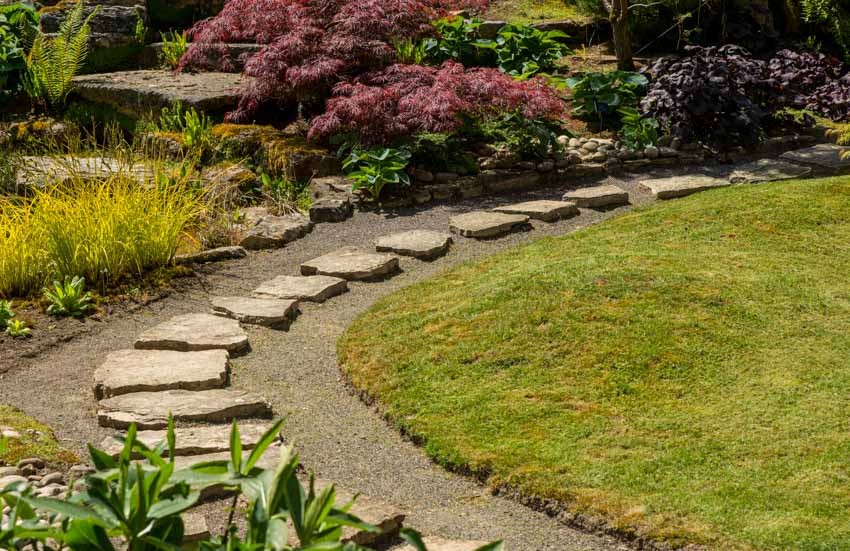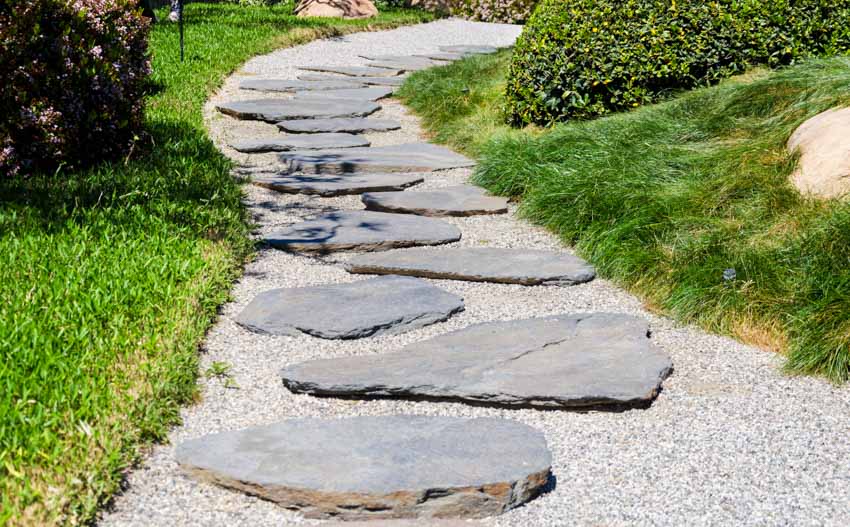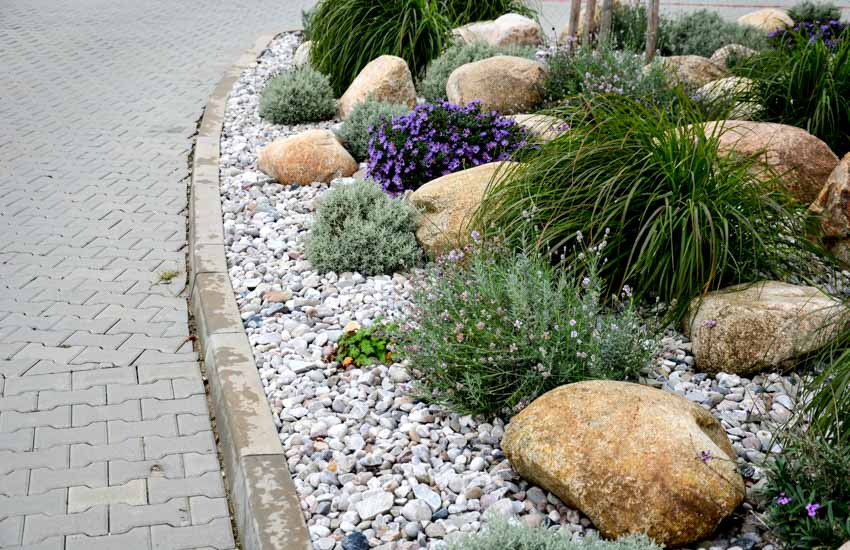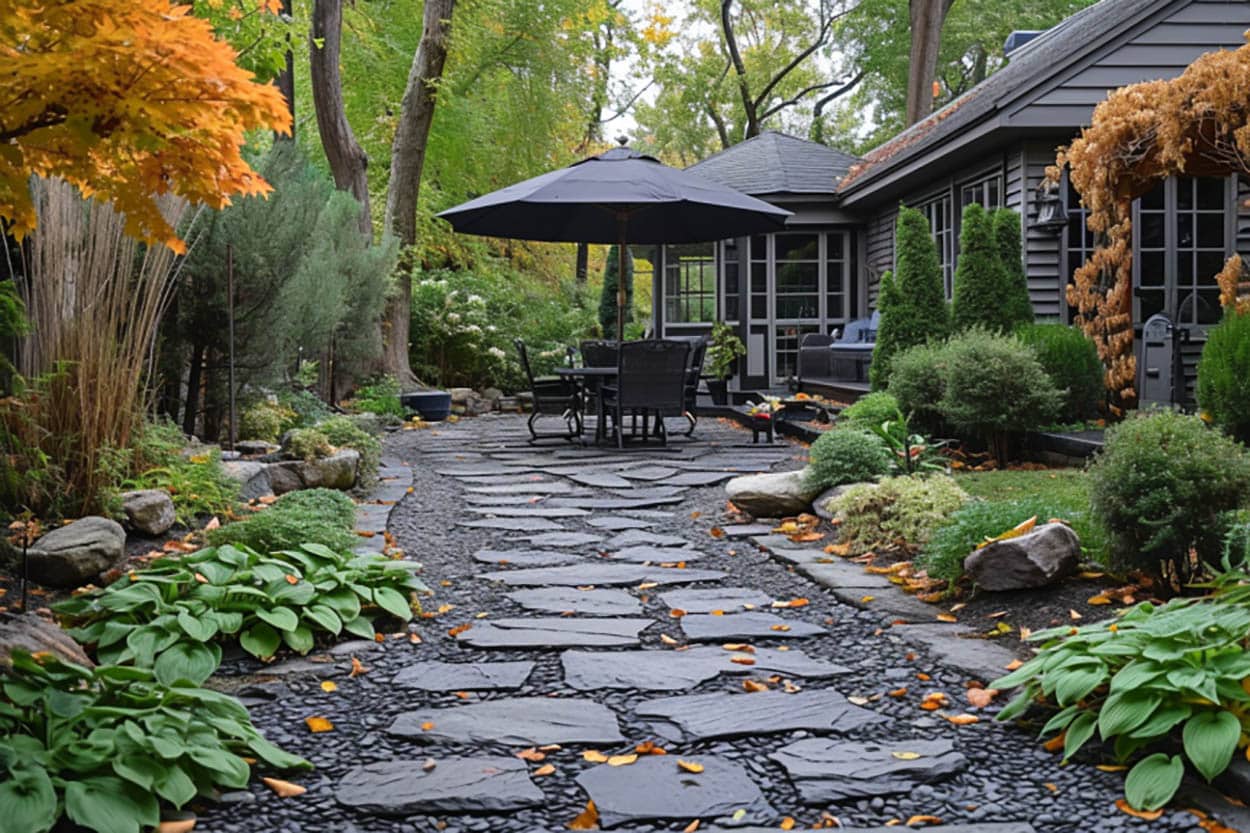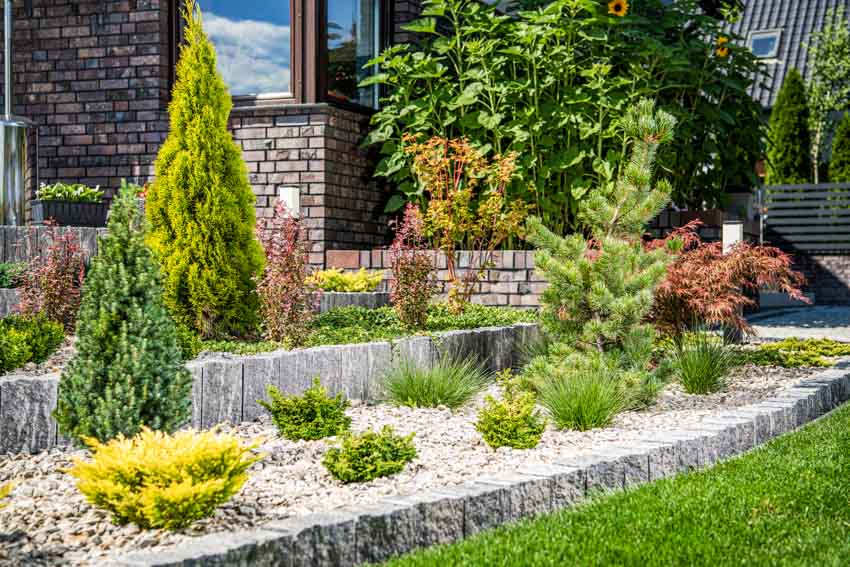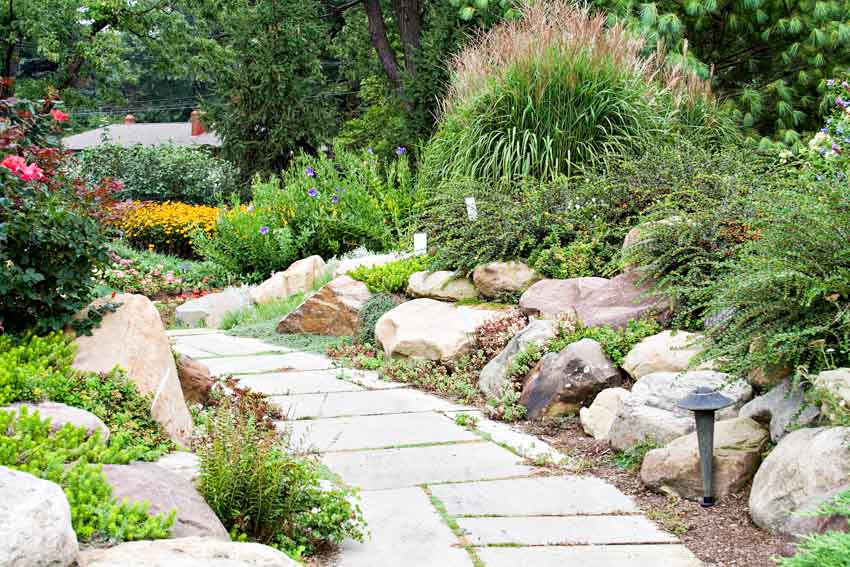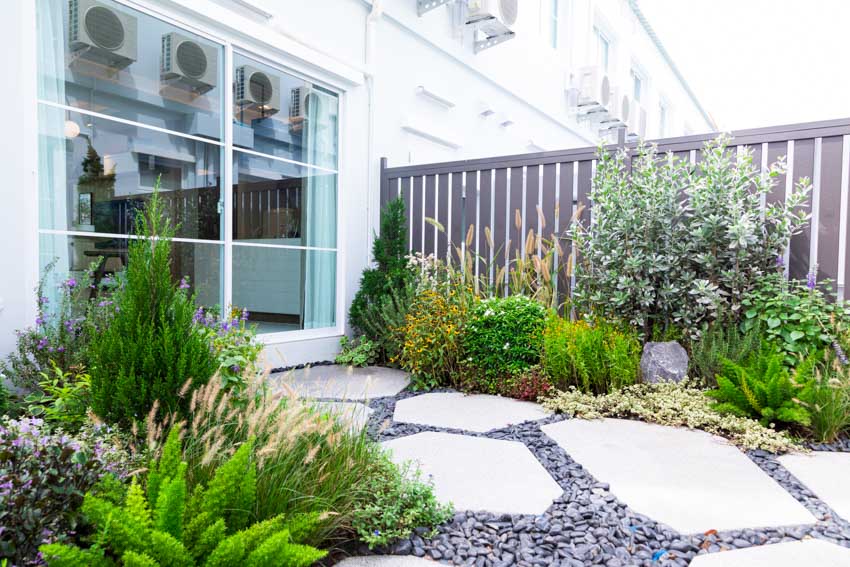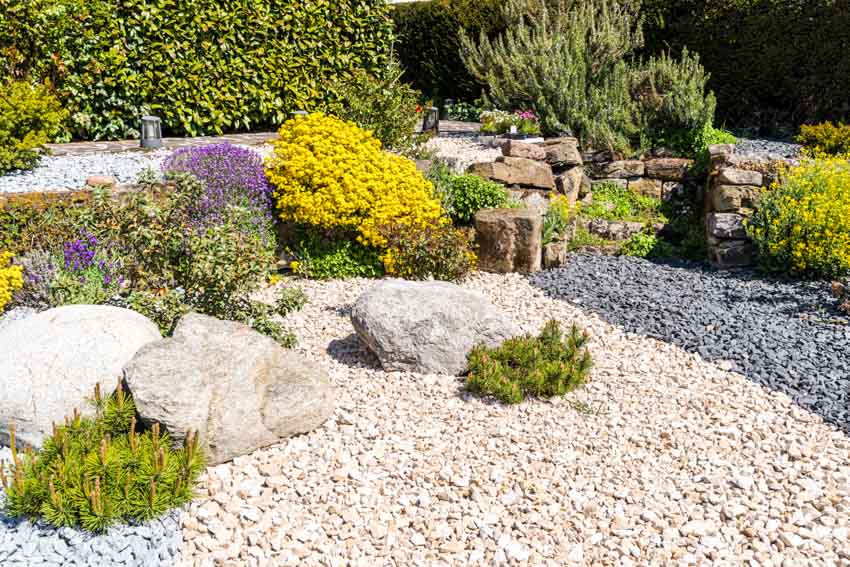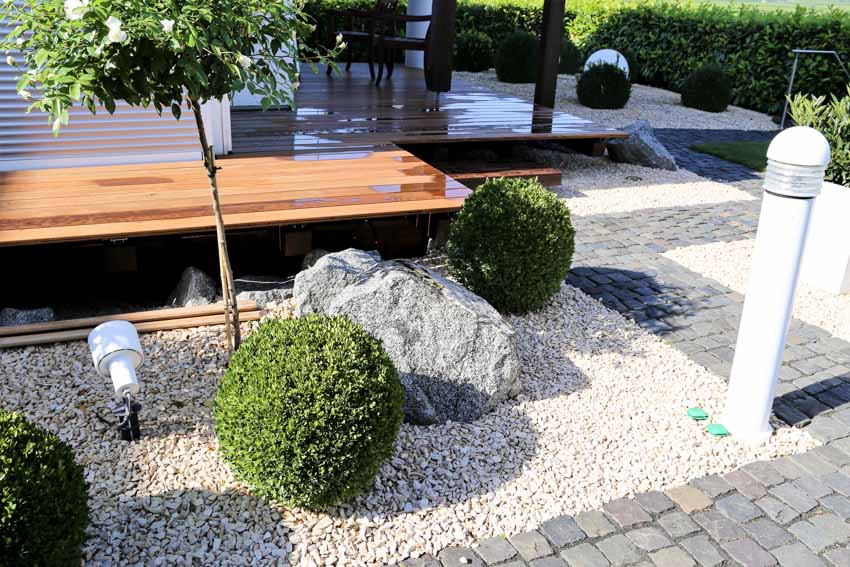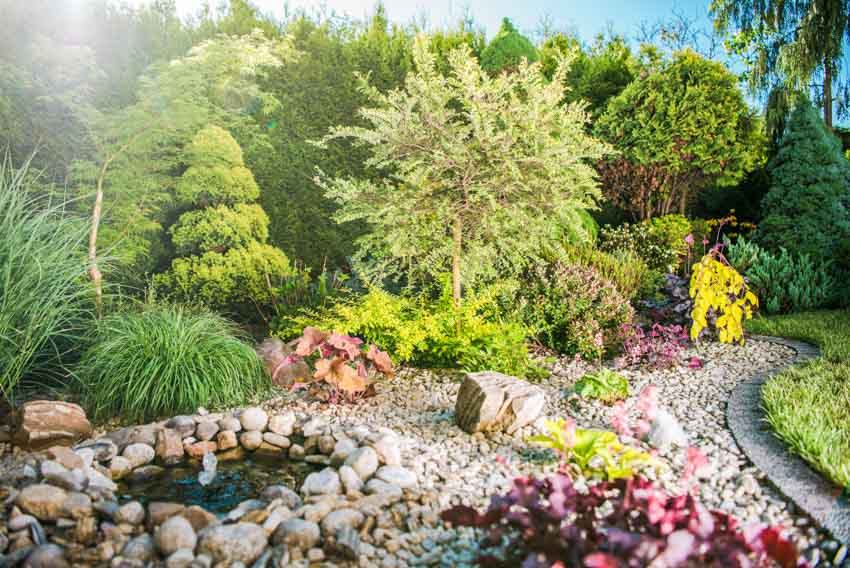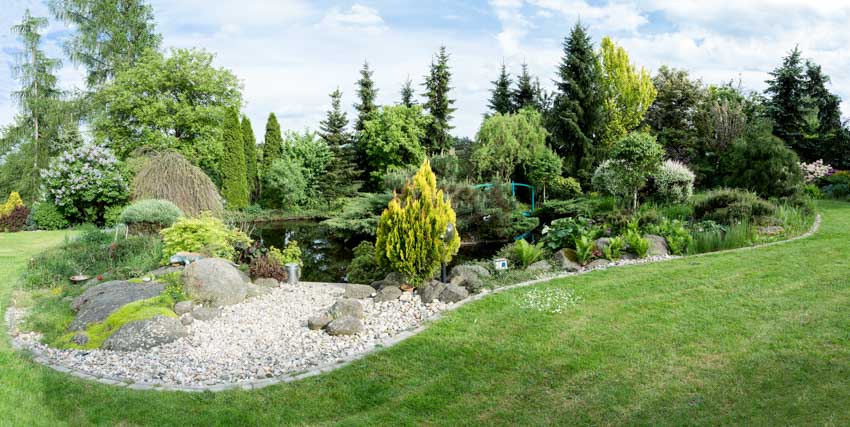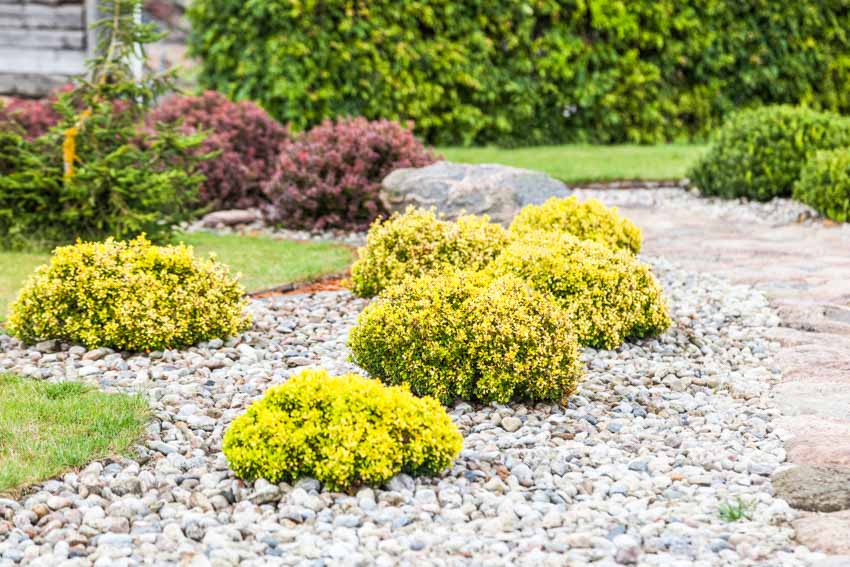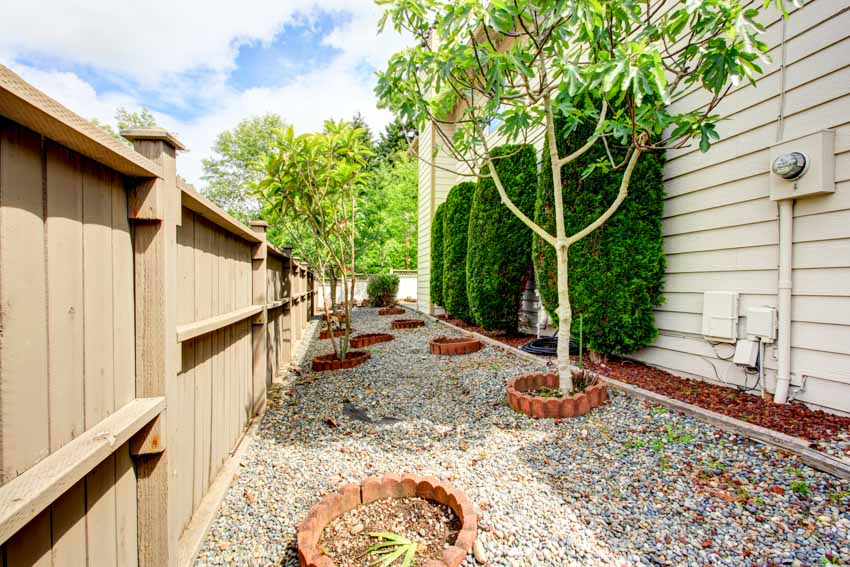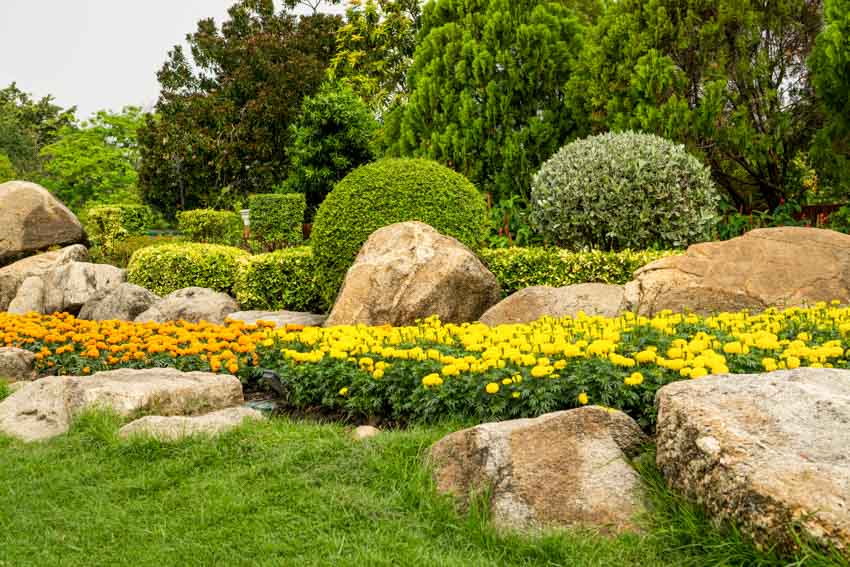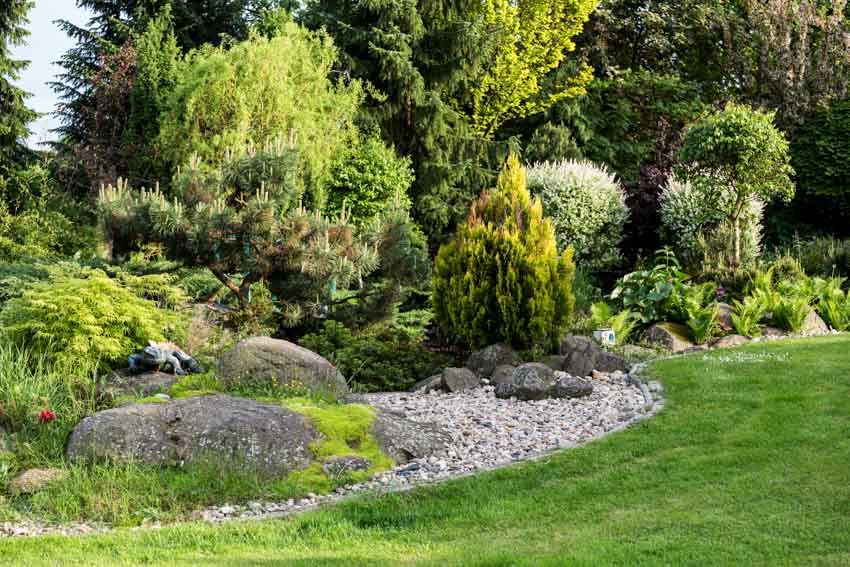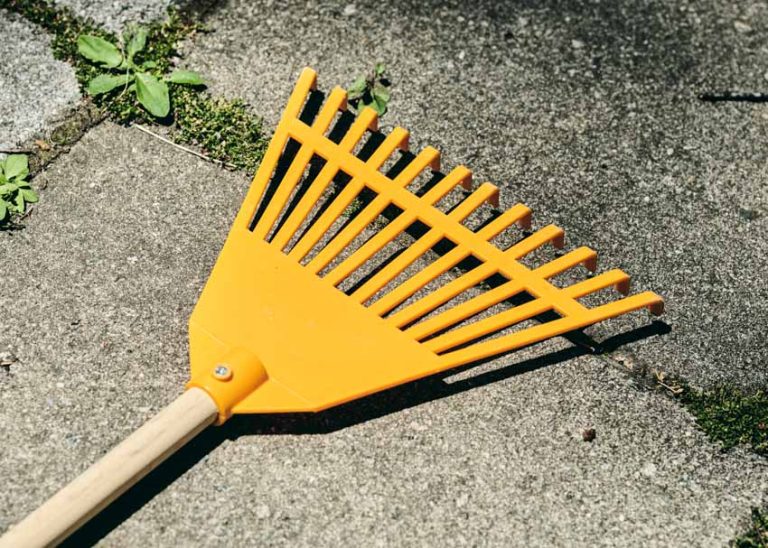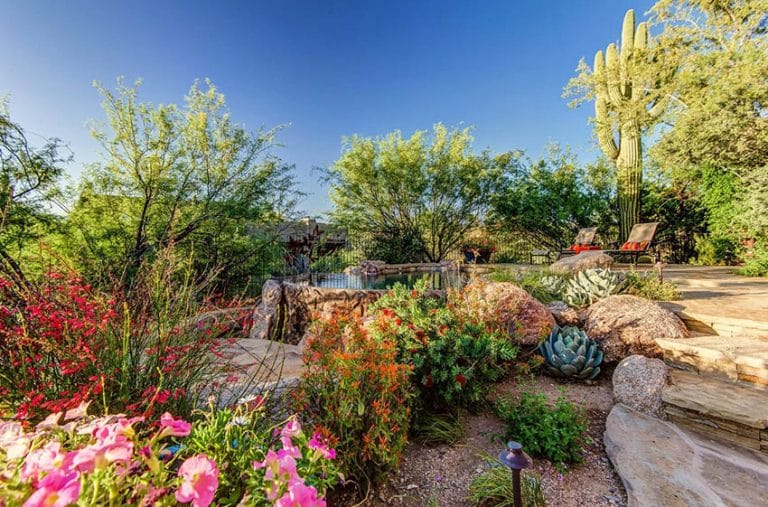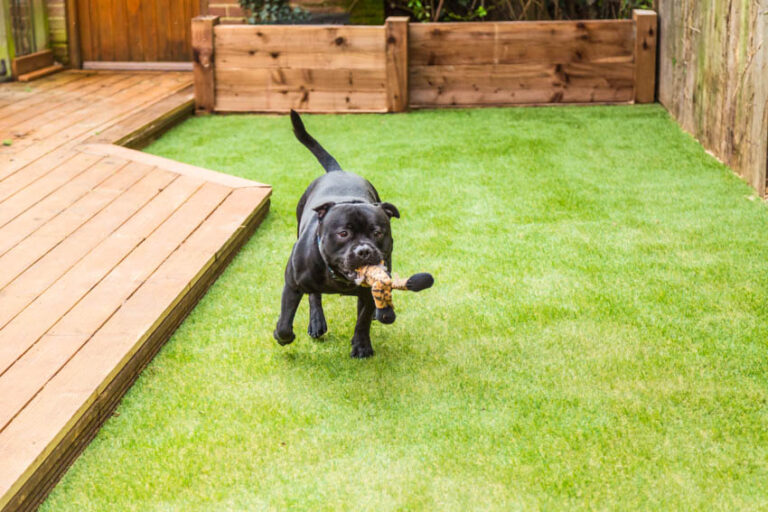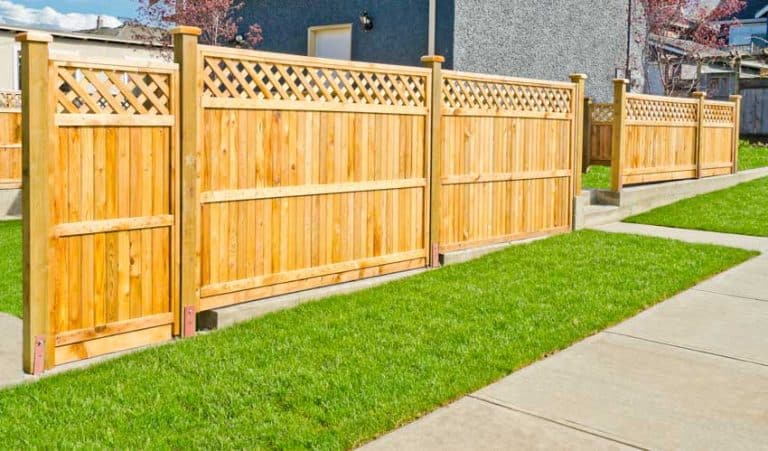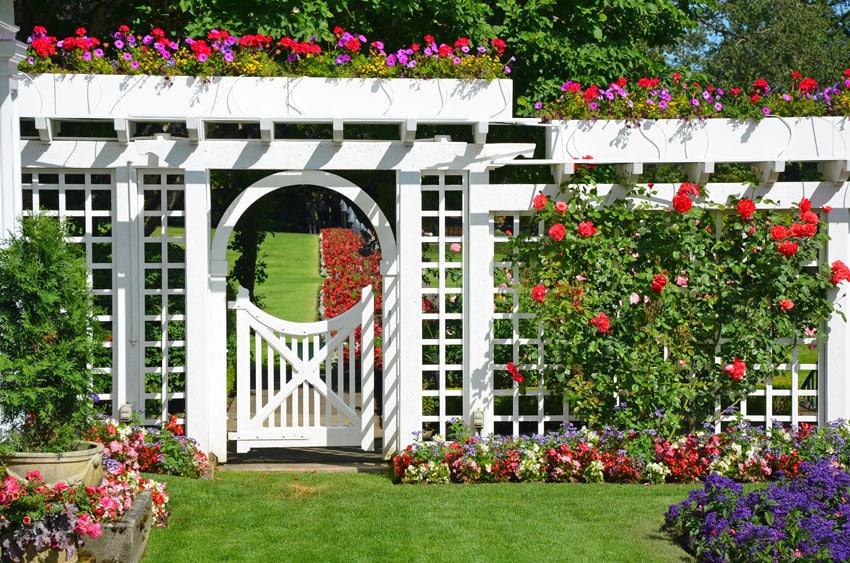14 Types Of Landscaping Rocks (Popular Options)
Although plants, grasses, and wood mulching are all acceptable landscaping solutions, they all require much maintenance, including irrigation. This maintenance takes too much time and effort, and water can raise utility costs. Nevertheless, using different types of landscaping rocks can be the simple answer to the challenges associated with spending time and money on your home’s landscape design.
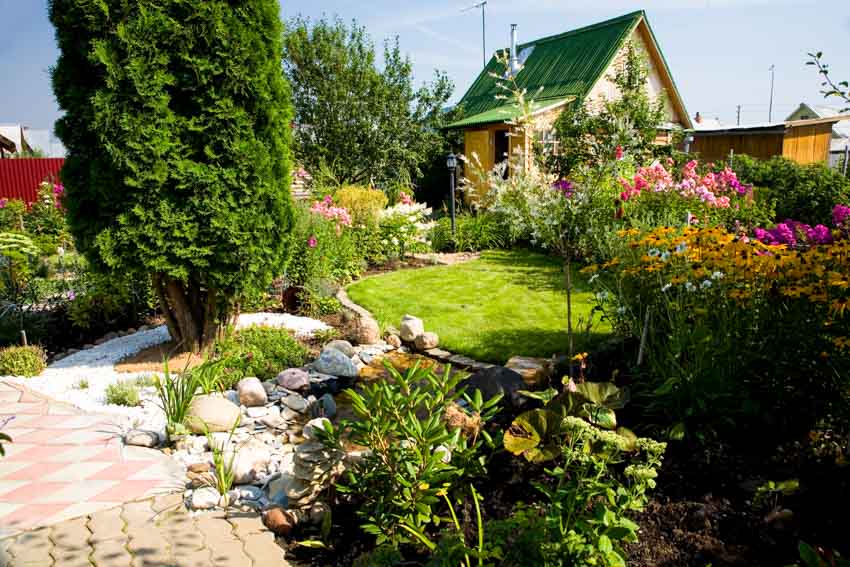
For many decades, residents have employed rocks for landscaping and gardening purposes. This involves using them for drainage and as aesthetic rock additions in a rock garden, for instance. Ahead, we will go over the various types of rocks you may use in your yard landscaping space – a great place to get rock garden design ideas.
What Are Rocks for Landscaping?
Landscaping rocks are rocks that are primarily used to enhance the appearance of gardens and front & backyard landscapes. They are available at landscaping supply stores, and most hardware and garden stores, as well as certain big box stores.
Landscaping rock is typically a loose assemblage of rock fragments. These stones form naturally as a result of sedimentary and erosive geologic operations all over the world. However, it is also widely manufactured in vast amounts as crushed stone. Here are the different types of landscape rocks:
Decomposed Granite
Decomposed granite is a natural granite byproduct. That is the same kind used for kitchen granite countertops. Only natural granite will corrode and crumble, resulting in decomposed granite. This granite is frequently crushed. Bigger particles should be used in open areas rather than in small garden sections.
Moreover, decomposed granite is one of the most adaptable rocks available. It is a type of granite that has been broken down to the point where only fine and small bits and pieces remain. It works effectively in places with poor drainage.
Because of the wide range of hues available in decomposed granite, you may find a fit for any formal or informal landscape. You can even utilize it as a border around garden walks to keep your walkway apart from the plants and flowers.
Ultimately, it is great for DIY pavements and comes in a variety of colors! It’s also reasonably priced, making it an excellent starting point for your new rock gardening.
Crushed Gravel
Crushed stone, also known as crushed gravel, is the powerhouse of landscaping rocks. They serve as a level surface for stepping stones and stairs as well as the foundation for nearly every water treatment. Typically, crushed gravels are made up of coarse sand combined with tiny stones.
Crushed gravel appears to be finer than broken stone. Gravel is formed by the forces of nature. As a natural consequence of machine-cut stone, quarries collect crushed stone. It is then trimmed to size and made available for purchase. See more types of gravel here.
Crushed Limestone
Crushed limestone is a calcium carbonate-based aggregate. The stone is mined and crushed to particular sizes before being utilized in a number of applications such as construction materials, landscaping, drainage, asphalt, infilling, and road foundations.
Moreover, crushed limestone is commonly mined from limestone or dolomite rock formations. The process entails breaking down gathered rocks to particular sizes using various rock crushers or machines, followed by screening or filtering into different grit sizes for applicable uses.
Nevertheless, due to machine grinding techniques, crushed or pulverized limestone pebbles are angular in shape and frequently have jagged corners. See moire examples of limestone driveway designs here.
Marble Rocks
Whenever you picture marble in your mind, you almost certainly think of luxury. This lovely landscape material adds a touch of luxury to every location it is placed in.
Since marble stone is manufactured from a high-pH rock, it will gradually raise the pH of the soil around it. Other plants, such as hydrangea flowers, benefit from this since their colors change depending on the acidity of the soil in which they develop.
Certain plants, on the contrary, demand more acidic soil, therefore, placing marble gravel that is surrounding a plant or flower arrangement with plants that necessitate acidic soil to thrive might not be the ideal choice.
River Rock
Another kind of smooth rock for landscaping is river rock. In landscaping, river rock is a more durable substitute for mulch. River rocks are a popular type of rock seen in landscaped gardens.
Because of the appealing design of this natural stone, it is frequently used to fill in intervals between stepping stones or as an ornamental rock drainage alternative for places that require it.
The seamless surface of river rocks makes them suitable to be used in a backyard water element. If you do not have a water element in your outdoor space or reside in an arid environment, river rocks can provide the same serenity to a front or backyard when utilized as an accent rock.
The general agreement on river rock size is that 1-inch river rocks are optimal, while these stones are obtainable in sizes up to 3 inches.
Larger rocks, on the other hand, leave openings between them, which might attract animals like snakes, particularly near a water element. Since the materials will not hurt your feet or ruin your shoes, they can also be used as pathways.
Pea Gravel
Pea gravel is a form of landscaping rock made out of rocks that are about the diameter of a pea. Pea gravel often have a seamless texture, making this form of landscaping rock visually appealing. Pea gravel’s aesthetic and physical appeal along with its price make it a popular variety of landscaping gravel.
In addition to its popularity as a landscape rock, pea gravel has a variety of other applications. These smaller boulders are typically utilized in high-traffic areas such as dog runs, playgrounds, pathways, and popular types of patios. Pea gravel, however, is useful in places that require drainage, such as underground constructions.
These gravel stones, which may be found near waterways and other bodies of water, come in a variety of neutral colors.
You can also use pea gravel for walking pathways, picnic spaces, playgrounds, and other high-traffic areas. This is also a good option around fire pits. People will not trip over a pea gravel-sized rock.
Pea gravel is bigger than decomposed granite and is ideal for covering gaps or serving as a protective top layer for children and pets.
Because you do not need a generous amount of pea gravel, the material is inexpensive when it comes to covering what you only need.
Brick Chips
Brick chips are a form of landscape rock manufactured from crushed, filtered, and shaped bricks for application in rock landscaping operations. They are commonly utilized for paths, baseball cautionary tracks, sidewalks, and planting areas.
Brick chips are quite beneficial for maintaining soil temperatures and holding hydration in soil. Both of these factors can aid in the development of healthy plants. Brick chips will not fade, decay, or disintegrate, nor will they attract pests. This renders them appealing as ground covering in a flower box.
Aside from that, brick chips can be used in almost anyplace in your landscape. Walking paths, plant beds, and even utility ground covering around sports fields have them.
Brick chips have a reddish-brown tint that can be painted with various colors. When you purchase brick chips in a shop, you will probably receive the “brick” color.
Adding another dimension, if you decide to use them, you must first lay down landscaping fabric to keep the pieces from sinking into the dirt and to keep weed seeds at bay.
Lava Rocks
Lava rocks are derived from volcanic lava that has chilled and crystallized. They come in a variety of earthy colors, the most common of which is scorched red. Lava rocks can be utilized for both drainage and water conservation.
They can also protect the soil in your garden from excessive heat and moisture. In a modern garden, black lava rocks are practically utilized.
Volcanic rock is another name for lava rocks. They can also be used as rock mulch because they do not degrade and do not need to be replaced like mulch. Because lava rocks are permeable, they can also be used for drainage.
This porous rock is lightweight and contrasts nicely with white gravel. Artistic shapes serve as accent pieces. Select them indiviually from a quarry. – John Deere 52 Backyard Landscaping Projects, Kristen Hampshire
In addition, this volcanic rock can be used to control the growth of weeds. A landscape fabric layer laid beneath a distribution of lava rock ground covering will help to reduce weed development in your garden.
To prevent weeds from sprouting between lava rocks, ensure there is no soil between the fabric and the volcanic rock layer. This includes making certain that the landscape fabric underlay is in excellent condition. Weeds can seed and develop if the soil is visible between such layers.
Lava rocks do not degrade and henceforth work well with standard weed barriers. Because they do not need to be refilled every year, they are an excellent solution for times when mulch is not needed.
Beach Pebbles
Beach pebbles have a similar impact to river rock but are smaller in size. They are suitable for walks and garden beds. Mexican beach pebbles are the most commonly used type in gardens. Because they have smooth underfoot, they can be utilized on any pathway.
Numerous homeowners prefer Mexican beach stones because they appear attractive. These are little round rocks with a smooth surface.
They are often grayish-black in color. Mexican beach pebbles are ideal for use in the landscape and bordering patios and beautifying the surrounding stones.
Mexican beach pebbles require little maintenance. They are spherical and come in various deep colors, such as black, deep crimson, black, and dark gray.
The seamless pebbles are hand-harvested in Mexico from basalt, a multi-toned volcanic rock. They look fantastic in containers with cacti and other sorts of xeriscape.
One thing to keep in mind is that they are not that affordable. Their increased price is because they are polished using a tumbling procedure that takes multiple weeks to finish.
The procedure necessitates the use of specialized equipment as well as a thorough understanding of various kinds of stones and their mineral qualities.
Riprap
Riprap is a type of rock fragment used to protect landscapes, shorelines, bridge bases, steep hills, and other shoreline infrastructure from scouring and erosion. The rocks utilized range in size from 4 inches to over 2 feet.
The size of the rock required for a project is determined by the slope’s steepness and the movement of the water. Riprap is a long-lasting, natural-looking treatment for landscapes.
Riprap is employed to minimize erosion linked with moving water along a lake coastline, along the outer bank of a river meander, distributing the power of the water on the embankment, or at bridges along banks and next to waterway supports.
Flagstone
Flagstones are sedimentary rocks that have been split up into layers. As pavement stones, they are commonly utilized in rock gardening in smoother areas, including a pathway or a driveway.
Flagstones can also be utilized to construct rock retaining structures, as stepping stones, as bordering around a landscape bed or other environmental border, or even as a fire pit surround.
Sandstone, as well as limestone, are the two most affordable forms of flagstones. However, bluestone and quartzite are also widely known in rock landscaping.
Such two latter types of landscaping rocks are both lovely ornamental stones. They can be filled with sand, but some tinier stones, such as pea gravel, are often used to encircle flagstone stepping stones and walkways.
Flagstones are suitable for all kinds of patios and pool settings. This rock is polished and frequently square or rectangular in shape. You can always put on a layer of sand before laying down the stones. However, if you want something more lasting, the flagstone should be set in concrete.
To balance the ground and descend into it, flagstones usually necessitate a base layer. This can be done with soil or thin gravel. This will hold the flagstones and keep them from swaying. See our gallery of flagstone patio ideas on this page.
Bluestone
Bluestone is among the types of landscaping rocks that are commonly used in building projects. There are two types of bluestone: sandstone Pennsylvania Bluestone and limestone Shenandoah Bluestone.
The first is a sedimentary rock made up of sand-sized grains, whereas the second is likewise a sedimentary rock yet made up largely of calcium carbonate.
Bluestone is long-lasting, beautiful, and suitable for a wide range of applications, such as patios, pool platforms, stone steps, and passageways. Both forms of bluestone from the United States have long been utilized as pavers in hardscapes.
Furthermore, bluestone pebbles are available in a variety of sizes and shapes, including squares and rectangles, or they can be trimmed for a more natural aesthetic with sharp corners and uneven shapes.
It is entirely up to you what you use in your pavement or landscaping project, while the uneven sizes offer themselves to more free-form patterns, including pathways with stepping stones. In addition, similar parts will be simpler to deal with because sketching out the area to cover will take less time.
Bluestone’s natural earth-tone colors are elegant and appealing, and they go well with practically any setting. Because of its rough surface, it is rarely smooth or slippery.
Furthermore, it is widely available and originates from quarries in the United States. Hence, there is no foreign transportation to add to its already rather high price.
Bluestone can withstand extreme weather and temperature changes; thus, you may include it in your landscape no matter where you live, whether you reside in a location with ice, snow, or extreme heat. Truly, bluestone is a high-quality landscaping rock. See pictures of bluestone patio designs here.
Landscape Boulders
Boulders are quite useful in landscaping. Although you will most likely need to pay a company to acquire, deliver, and install them, they appear wonderful and can also be used as retaining walls.
Boulders offer texture and interest to any yard, whether they are spread in a vast garden, stacked, positioned around the foot of a tree, or used in other creative ways. Landscape boulders are an important part of any landscape design. Boulders are big landscape rocks with a diameter of at least one foot.
These enormous landscape rocks are classified into two categories. The first are stones with a spherical surface. The second form of stone is called angular or quarried. They are available in a wide range of colors, forms, and sizes.
A boulder is defined as any rock with a diameter greater than 10 inches. This ranges from little enough to be carried to large enough to require a crane to move.
While no two rocks are the same, their shapes are classified as round or angular. Angular rocks feature sharp edges and flat surfaces, whereas circular boulders are seamless and water-worn.
Slate
Slate is an excellent material for landscaping due to its attractive and stylish look for borders around pathways and planters. Its elegant appearance showcases a range of hues, such as light-and-dark grays, blues, greens, reds, and even purples. In addition, it is a durable material, making it a superior choice for areas with many weather fluctuations.
This natural stone can be used for paving stone pathways, paver patios, borders, mulch, and around water features with great results. With its thermal resistance, it also maintains a consistent temperature, making it more comfortable to walk on than other choices.
When used as a mulch ground cover, it can help retain the soil around plants and help reduce the need for watering while protecting the plants’ roots.
Natural Rocks for Backyard Landscaping
Natural types of landscaping rocks are among the most adaptable components obtainable for a landscape remodel. Rock landscaping offers texture and contrast while also offering a resilient ground cover that necessitates minimal to zero upkeep.
Integrating rocks into your landscape is an investment that will pay off in the form of visually appealing, low-maintenance, and long-lasting effects. Walls, water features, and rock gardens are just a few of the unique aspects that may be added to a lawn or garden with rocks.
They can also be a long-lasting alternative to mulch that does not need to be renewed year after year. Take into account the vibe you want your environment to portray while selecting rocks for your landscape.
Rock Landscaping Cost
You can anticipate spending around $40 to $800 per ton, depending on the material you select. The size, shape, color, as well as finish, are all cost concerns. Furthermore, as the amount increases, you will typically pay less per unit. Thus, you can save money by acquiring everything you need all at once.
Here are the average costs for these types of landscaping rocks:
• Decorative Landscaping Rock: around $40 to $500 per ton (it depends on the material, style, and importing process)
• Lava Rock: around $75 per ton, around $75 to $120 per cubic yard, and around $7 to $10 per bag.
• River Rock: around $100 to $800 per ton (the price is determined by the size, shape, color, and finish of the stone)
• Large Boulder: around $100 to $800 per ton (the ones with unique colors and shapes have higher costs)
• River Rock Gravel: around $40 to $45 per ton, around $30 to $35 per cubic yard
• Granite: around $50 to $70 per yard, around $1 to $4 per bag (the crushed version is larger and more expensive than the decomposed granite version)
• Crushed Stone or Gravel: around $50 to $65 per ton around $40 to $55 per cubic yard
• Mexican Beach Pebble: around $20 to $40 per bag
If you’re on a budget there are also places you can find free landscaping materials such as small stones, sand, and boulders. Often you will have to pick up, load and haul the materials yourself. However, doing so can offer a substantial savings over purchasing from a landscape supply store.
How Much Does It Cost to Have Rock Installed?
Landscaping rock installation projects typically cost approximately $600 to $700. Purchase and installation of medium to large-sized rocks, stones, and boulders in the landscape might cost as low as $460 or as high as $1,000.
You can anticipate paying $20 to $100 per cubic yard of landscape stone, or $0.75 to $4 per cubic foot, contingent on the material you pick.
Rock Removal Cost
The cost to excavate or remove landscape rocks from your property after they have been installed ranges from $50 to $200 per cubic yard. The majority of landscape rock removal services will charge around $40 to $150 per hour.
Several people remove rocks for practical or aesthetic reasons, such as making way for a new pool or patio, or changing landscaping installed by a former homeowner.
What Is The Cheapest Type Of Rock?
Talking about the cheapest types of landscaping rocks, crushed gravel and pea gravel would be the top choices. You may, nevertheless, come across alternative types at a reasonable price. You can always try to look into the various types of landscaping stones in abundance in your specific area and get amazing deals.
How To Choose The Best Rocks
Understand All the Types of Landscaping Rocks: There are numerous sorts of landscape rocks – some can either be smaller or larger than others.
Before you begin any project, make sure you understand each type so you know what you are actually working and dealing with.
There are two important things to mind while selecting small landscaping rocks. The first is to use excellent edging stones to hold the pieces in position. The second consideration is their function—if you intend to stroll on the small rocks barefoot, you have to make sure that you pick a smooth option.
Maintain the Style of Your Home When Working With Your Landscaping Project: This is, without a doubt, one of the most crucial considerations when decorating your environment using stones and boulders. After all, the goal is to improve the appearance of your property.
Go with stone like flagstone and crushed stone that radiates a clean, modern atmosphere if your home’s décor is modern and trendy.
Multicolored types of landscaping rocks will give off that wonderfully unpolished vibe you have crafted if your home is more rustic in style.
Spanish-style homes look excellent with cobblestone types of driveways, while Colonial-style homes frequently have stones in the landscape to provide a modern edge to their ancient design.
Design with Function in Mind: What kind of environment are you creating? Do you plan to utilize it for recreation or as a walkway? Will you include a water feature or an outdoor fire pit? Maybe you want a drought tolerant desert landscape design to cut down on water costs.
It is indeed a smart idea to map out your ideas before you begin so you know you are designing with functionality in consideration.
For example, gravel may look nice on the ground beside your fire pit, but it might be hard on your feet. Alternatively, choose pebbles, which are more comfortable to walk on barefoot.
Patio pavers are also ideal for creating the quintessential outdoor hangout area. Pavers are long-lasting, smooth, and available in a wide range of colors and designs.
Before making any purchases, make it clear that your design considers both appearance and function!
Employ Stones to Make a Shape: One of the finest advantages to utilize landscape stones in your garden is that you can use them to create shapes and places that do not exist otherwise.
You can create your stone arrangement to indicate a certain region of your garden if you want to bring attention to it. You can also move your pattern far from places you do not like and toward parts that you like.
Depending on your preferences, you can also utilize your stones to make your home feel larger or cozier. Larger stones will make your area feel more contemporary and open, whereas smaller stones and crushed gravel will give your home a comforting, old-world atmosphere.
Take Into Account Installing a Water Feature: A water feature is the best way to portray luxury in a room. They are also extremely relaxing—eating out on the terrace while listening to a waterfall flow alongside.
There are numerous methods to include a water element in your landscape design. You can create a small waterfall as the focal point of your garden.
You may carve out a small river that meanders through your property, bringing nature’s rhythms and vitality straight into your own backyard.
Ponds are also a delightful addition to any landscape. Just ensure you study up on its maintenance before installing this water feature.
What Are The Best Rocks for Home Landscaping?
There is no such thing as a bad choice when it pertains to landscaping rocks. All of the rocks for landscaping possibilities listed above have unique characteristics as well as practical applications, and they are all visually beautiful. Whichever type of landscaping rocks you use is entirely up to you as well as your tastes and requirements.
Actually, this is highly dependent on where you live, what is accessible, your budget, what you intend to use the rocks for, and the look you desire. However, based on the decisions of multiple homeowners about their landscaping rock options, these would arguably be the best rocks for landscaping:
Pea Gravel: Pea gravel rocks are extremely little and flawless because mother nature has already polished them. They can be used to fill flower beds and little gaps. They are, indeed, among the best types of landscaping rocks.
Lava Rock: Lava rock is widely known among homeowners as a viable replacement for mulch in flower arrangements. The rough, deformed red boulders are slightly more expensive than pea gravel, but they make a fantastic long-term investment.
River Rock: River rocks, which are more polished than pea gravel and much larger, can be utilized for more than just filling in around bushes.
You can stack them, use them to border a flower bed, construct a retaining wall, or fill in some open space for a vibrant patch of stone. This is a smart option to beautify your landscape.
Flagstone: Flagstone, probably the most popular material for walkways and patios, has various advantages. It is available in a variety of colors, enables water to distribute instead of run off, and is very resilient. You can also intersperse genuine grass or vegetation between the stones.
Brick: Customarily made of clay, modern bricks are made of a variety of materials. This is a multipurpose landscaping rock that can genuinely shine with the right design.
Bricks, for instance, can be used to construct a patio, walkways, or an elevated garden. Alternatively, you can organize bricks in a distinctive style that meets your preferences.
How Thick Should the Rock Layer Be?
The size of the particular landscape rocks determines the recommended thickness or depth of coverage. If the stone is 0.5 inches or less, the recommended depth would be 2 inches.
Stones ranging in size from 0.75 to 1 inch should have a thickness of roughly 3 inches. The types of landscaping rocks that are 1 inch or larger must be 4 inches thick.
How Much Rock Do I Need?
When designing a landscaping project with rocks, one critical consideration is how many rocks you will have to use. Calculating correctly can save you money and time. You would not want to purchase too little rock and end up with insufficient coverage for your landscape.
However, if you purchase excessively, you will waste money and time dispersing it. When determining the quantity of landscape rock to purchase for your project, there are two aspects to be considered:
• The amount of space you are covering
• How wide and deep you would like the coverage to be
Start measuring the length and width of your project space to determine the size. Multiply these two figures to get the square footage of your coverage zone. Your coverage zone is 360 square feet if your project is 18 feet in length by 20 feet in width.
Thereafter, pick how extensive you want your coverage to be. For most applications, 2 inches of material will suffice. If you are employing materials that are bigger than 2 inches, the depth will most likely be the size of the rocks, which means you will only need one layer of 3 x 8 inches of rocks.
What Are Large Rocks Called?
Boulders, another term for large landscaping rocks that are massive and commanding, offer beauty and usefulness to your landscape. Boulders appear in a multitude of natural colors since they are made from various types of landscaping rocks.
Even though carved boulders can be made, they are often jagged and naturally formed. Boulders can be used for a plethora of landscaping purposes.
These massive rocks are used to terrace lawns and protect homes where someone might drive across your lawn.
These large and attractive stones can serve as focal pieces in any garden while also preventing plants from spreading into one another. Boulders can also be used to create a more natural aspect surrounding ponds and waterfalls.
How To Clean Rocks
Here we share the best tips and steps to follow when cleaning landscape rocks.
1. Landscape Rock Cleaning Tips and Techniques
• Start using a leaf blower to clear as much dirt as possible from the rocks.
• Dig down to see if there is landscaping fabric or plastic sheet beneath the rocks. Soak the rocks with water using a hose without using its nozzle first, allowing the water to move particles out of the rocks.
• Under the rocks, washing works effectively with landscape fabric or plastic. Cleansing the rocks in the flower or gardening bed without the fabric or plastic may overly saturate the soil and induce root rotting.
• Move the stained types of landscaping rocks using a shovel into a wheelbarrow or durable containers. Filtering detritus from the rocks may be essential. You should work in little portions.
Fill the containers or wheelbarrows halfway or less with rocks so you can still lift and carry them. To clean the rocks, use a spraying nozzle.
• Pour water into the rock containers. If your rocks are still discolored after you cleanse them using the sprayer, you can cover them with 1 part chlorine bleach to 2 parts water for rinsing. Do not ever spill bleach on vegetation if you use it in the water!
2. Steps on Cleaning Boulder Rocks
• Eliminate any loose dirt with a broom.
• To remove muck, rinse with a garden hose.
• Algae and moss can be removed off the rocks by scrubbing them with vinegar and a scrub brush.
• After cleaning with a garden hose, re-rinse the landscape rocks.
Take note: There is no need to clean your rocks on an extreme regular basis; a yearly or bi-yearly cleaning should be enough.
See more related content in our article about landscaping with sand on this page.

